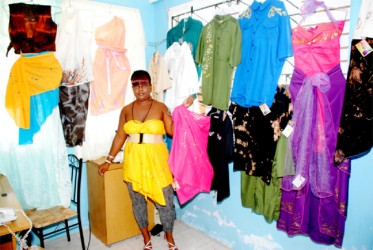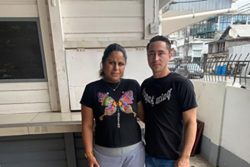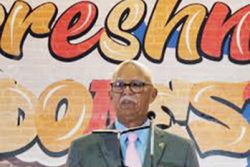At 28, Habibah Atherley-McGregor demonstrates both the exuberance of youth and the eagerness to convert her creative talents into commercial success. She understands that she has entered a highly competitive world of the creative arts. Still, after five years of running a business of her own, she makes no secret of a passionate desire to have real success come her way.
She is known as Akilah and Akilah’s Creations is her shop, or perhaps more appropriately, a mirror of her talents. The space contains impressive design options offered in tie-dye and fabric-painted material. Akilah is an artist, a graduate of the Burrowes School of Art and what she offers her customers includes screen-printed designs which she conceptualises herself.
Akilah is as eye-catching on canvas as she is on fabric. She displays numerous portraits which she paints to order.
Her main challenge reposes in the limits of the market. She concedes that prices for creative work are often beyond the reach of what one might call the average spender. Then there is the competition from the cheaper fashion imports. Still, she takes as much advantage as she can from the niches in the local market; those persons who “want to look different”. They would seek her out, sometimes with fashion requests that challenge her creative imagination. Those people, she says, understand the methods by which designer clothing is valued.

There are times, she says, when she seeks to meet average spenders. It is a concession to the vagaries of the local market as well as an understanding of the passion for ‘nice things’ even among those who might be unable to afford such acquisitions. It is, she says, a matter of “how much you are willing to spend.” That approach saves time that might otherwise be spent haggling. Even then, there are times when clothing is ordered and never collected. In those circumstances the pieces are sold after a period of waiting. Understandably, there are now cases in which she requires advance payments.
She is understanding of the less discerning, those who would compare her prices with the lower end clothing. Well-off clients can be trying too. There are occasions when intricate cocktail dresses or elaborate bridal gowns would be required at short notice. That, she says, is an occupational hazard of the industry.
Sometimes, too, she is challenged by what she regards as the dichotomy between “what the client wants” and her own fashion advice.
Her creations derive from her artistic imagination. The creations of the clothes and the painting come from her imagination and her moods. Her preferences in terms of fabric are for linen and cotton. Her concerns, the main ones, that is, have to do with sub-standard fabric sold by some local establishments. They excuse themselves on the grounds of “manufacturers’ faults”. That does not satisfy Akilah. These days she favours cotton imported from Brazil and linen sourced in Trinidad and Tobago.
Some of her marketing is done through fashion shows at Sidewalk Café. Paintings are on display at the Dutch Bottle Café on North Road. Her pieces are also displayed at the various exhibitions and craft shows hosted by the Art and Craft Association.
Every year, since 2009, Akilah has been running a stall at GuyExpo. It is there, she says, that she has secured most of her customers. Beyond exhibitions and GuyExpo she shows off her creations through visits to workplaces and stores. She has also been known to stop persons on the streets.
In 2010, she was offered space at a stall in front of the General Post Office for one week to sell her clothing. The public response was dramatic. “Sales were remarkable,” she says, so she decided to approach the owner about renting or selling. The offer was “$3 million and the stall is yours.”
Akilah has pursued various courses at the Institute of Private Enterprise Development (IPED).
She wants to correct what she says is “the myth” that the Burrowes School of Art is simply “about drawing and painting. It prepared me for the world of work. It taught me how to survive,” she says.
Akilah also attended the Dickson School of Sewing on South Road after which she served as its administrator for one year. Her mother, a seamstress, helped to guide her in that direction. She recalls that as a child she sewed dolls’ clothing.
At Central High School she had been introduced to those disciplines that helped prepare you for a possible career in commerce; like Clothing Design and Textiles Art and Clothing and Textiles. She pursued those courses, among others, at the Caribbean Secondary Education Certificate examinations, before enrolling at the Dickson School.
She also spent two years in Barbados and was afforded the opportunity to participate in the Barbados Fashion Weekend. Some of her designs were sold and the local newspapers acknowledged her participation but, she says, “it was by no means a success.” She was also associated with local fashion designer Sonia Noel for a brief period.
The relatively slow pace of progress has not daunted her spirits. Her focus is clear. She wants to remain a creative spirit but seeks to marry that to a focus on commercial success in her chosen field. Apart from creating earning power, she believes that commercial patronage is one of the barometers by which you measure success.
These days, she looks to Suriname in August, and more particularly to the 11th staging of the Caribbean Festival of Arts (Carifesta) as yet another opportunity to present her work to the region.







